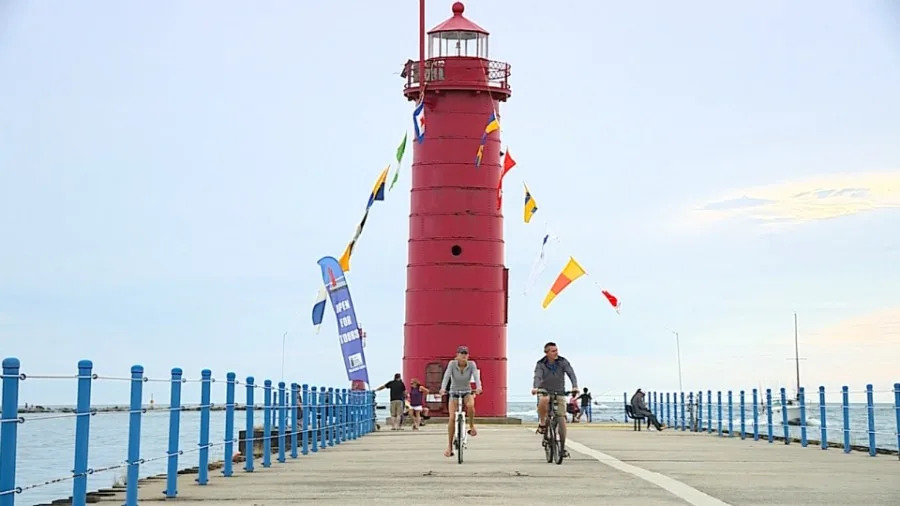
GRAND RAPIDS, Mich. (WOOD) — New York has the Statue of Liberty. California’s got the Hollywood Sign and the Golden Gate Bridge. Missouri has the Gateway Arch. What monument comes to mind when you think of Michigan?
Some may think there’s an obvious answer — I do — but it turns out plenty of Michiganders believe it’s up for debate.
So what is it? We took the question to News 8’s viewers. Here are the top 8 responses.
PAUL BUNYAN

Several people mentioned the Paul Bunyan statue in Oscoda. The 13-foot tall statue is a fun, campy way to celebrate a piece of local folklore, especially since the state of Michigan declared the city the legend’s official birthplace in 2006.
The earliest stories of Paul Bunyan first appeared in print in 1906 in the Oscoda Press, written by a man who previously worked as a lumberjack before becoming a newspaper editor.
One hometown isn’t enough for such a larger-than-life folk hero. Several other places claim Bunyan as one of their own, including cities in Minnesota, Wisconsin, Maine and even Nova Scotia. Staying true to form, Oscoda’s statue isn’t the only Paul Bunyan monument in Michigan. There are also monuments in Manistique, St. Ignace and Ossineke, about 35 miles north of Oscoda.
THE UNDERGROUND RAILROAD MONUMENT

Michiganders take pride in their ancestors’ role of fighting to end slavery. Battle Creek was one of the key stops on the famous Underground Railroad, which helped slaves from the South make their way to freedom. To honor the memory, a monument was resurrected in the city.
The sculpture, 28 feet long and 14 feet tall, features Harriet Tubman on one side and Sarah and Erastus Hussey on the other. As Quakers, the Husseys were outspoken opponents of slavery and played a prominent role in the city.
Tubman never actually passed through Battle Creek, but another popular abolitionist made Battle Creek her home. After escaping slavery in New York, Sojourner Truth eventually settled in Michigan and lived in Battle Creek for nearly 30 years before she died in 1883.
THE SOO LOCKS

The Soo Locks aren’t necessarily a monument, per se, but they are such a feat of human genius and so vital to the American economy that they certainly deserve the recognition.
The locks, set on the St. Marys River in Sault Ste. Marie, date back to the middle of the 19th century. The locks allow ships to navigate a 21-foot drop and bypass a set of rapids to painlessly access Lake Superior and Lake Huron.
The locks typically handle more than 80 million tons of cargo each year, including virtually all of America’s iron ore. Closures can result in hundreds of millions of dollars in economic losses.
THE FIST

“The Fist” may be more representative of Detroit than Michigan as a whole, but it’s more than cool enough to merit a mention. The giant sculpture, a 24-foot bronze model of Joe Louis’ right arm, hangs in the air, suspended by a 24-foot-tall pyramid. It was dedicated to the boxer in 1986.
The sleek sculpture has become a symbol for the city, embracing adversity with grace and toughness, just like Louis.
The world heavyweight champion from 1937 until a temporary retirement in 1949, Louis is widely regarded as one of the greatest boxers of all time. One of his biggest wins was against Max Schmeling in 1938. It was fought in the shadow of the growing Third Reich and anti-Nazi sentiment, putting Louis in an odd spot of being both championed by the country and hated for being a successful African American.
THE GRAND HOTEL

Mackinac Island! Fudge! Arch Rock! Horses… Mackinac Island on its own stands out as a Michigan treasure, and the Grand Hotel is the island’s crown jewel.
The Grand Hotel has welcomed vacationers for nearly 140 summers, offering luxury, relaxation and a unique blend of timeless Americana. The hotel has hosted five U.S. presidents, Thomas Edison and even lectures from Mark Twain.
The Grand Hotel was added to the National Register of Historic Places in 1972 and declared a national landmark in 1989.
‘BIG RED’

A lot of viewers believe Michigan’s lighthouses epitomize the state, and Holland’s “Big Red” lighthouse got the most love, so it makes the cut. And to be fair, it is awesome.
The lighthouse dates back to 1870, keeping watch over the Holland channel. The current structure, a steel tower, was built in 1907 and has been the backdrop of countless lakeshore photos and memories.
In 1971, the U.S. Coast Guard declared the lighthouse to be a “surplus” and could not justify maintaining it. Local residents started a petition, formed the Holland Harbor Lighthouse Historical Commission and eventually took ownership of Big Red. Now, the Coast Guard comes out twice a year to inspect and maintain the light.
PICTURED ROCKS

Not necessarily a monument, just pure unadulterated natural beauty. Pictured Rocks National Lakeshore is one of my favorites and arguably one of the most naturally beautiful places on the planet. And it’s right here in Michigan.
Pictured Rocks National Lakeshore pulls its name from the stretch of sandstone cliffs off the coast of Munising that have been slowly carved by groundwater that leaves streaks of color. Some cliffs have more patches of red, caused by residual iron, or yellow (limonite), black and white (manganese) and green and pink (copper).
Pictured Rocks National Lakeshore was founded in 1966. It protects 15 miles of cliffs and more than 100 miles of trails. The park regularly draws more than a million visitors each year.
THE MIGHTY MAC

The Mackinac Bridge was the most popular response, and for good reason. Part of what separates Michigan from every other state is our two peninsulas, so the icon that connects them is a perfect fit, particularly when that icon is an engineering marvel.
The bridge, which opened in 1957, is nearly 5 miles long and is considered the longest suspension bridge between anchorages in the Western Hemisphere. It is comprised of 42,000 miles of wire, weighing a combined 11,8409 tons. The bridge itself weighs more than 1 million tons, including more than 930,000 tons of concrete.
More than 3.6 million vehicles typically cross the bridge each year. August is typically the bridge’s busiest month. According to the Mackinac Bridge Authority, more than 640,000 thousand vehicles crossed last August.
HONORABLE MENTIONS
There are plenty of other monuments that merit consideration. Some of them aren’t exactly great fits. For example, the “Calder” in Grand Rapids — La Grande Vitesse for the uninitiated — is much more representative of the city compared to the state.
And there are a lot of other quirky options similar to the Paul Bunyan statue, but they simply aren’t as well known, like the roadside giraffe in Buckley or Penny the Truck-Eating Bridge in Lansing.
The great thing about the recognized monuments is that they illustrate part of what makes Michigan great. This state is home to history, to art, to nature and to so many diverse communities that make it unique.
Copyright 2025 Nexstar Media, Inc. All rights reserved. This material may not be published, broadcast, rewritten, or redistributed.
For the latest news, weather, sports, and streaming video, head to WOODTV.com.






Comments